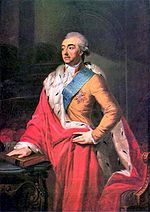
Born: December 1, 1734, Gdansk, Poland
Died: March 19, 1823, Sieniawa (Austro-Hungarian partition of Poland)
Early days. Father: Prince August Aleksander Czartoryski, governor of Ruthenia, who gathered a great estate and founded prosperous workshops, Mother : Maria Zofia Sieniawska. Adam Kazimierz was educated in England and prepared to take over the Polish throne.
Career. After his return to Poland in 1758, he became a member of the Sejm (parliament), Crown General of Podolia and Marshal of General Confederation of Kingdom of Poland. But in the period when Poland was left without an elected king, Adam Kazimierz refused the crown (1763), which was accepted by his first cousin Stanisław August Poniatowski, who reigned as Stanisław II August. The interests of Adam Kazimierz were mainly literary and pedagogical. He founded periodicals and schools and became the first minister of education in a European country. By his efforts and those of his ambitious wife, Izabella Elżbieta, née Countess Flemming the daughter of Count Georg Detlev von Flemming and Princess Antonina Czartoryska. (marriage in 1761), their palace at Puławy became an important center of culture competing with royal patronage in the support of Neoclassical architecture and Polish literature; this provided an excellent school for their sons and those of the local gentry. After the downfall and the third partition of Poland in 1795, Puławy, ruined in 1792–94 and rebuilt, became the shrine of the country’s past, mainly through Princess Izabella’s efforts. In 1765 he co-founded the Monitor, the leading periodical of the Polish Enlightenment. In 1766 he reorganized the army of the Grand Duchy of Lithuania. In 1767 he joined the Radom Confederation. In 1768 he became the commander of the School of Chivalry (Corps of Cadets). In 1788-1792 he was Deputy from Lublin to the "Four-Year Sejm”. Drawing closer the king once again, he became a leader of the Patriotic Party and co-founder of Poland's Commission of National Education. He supported the Polish Constitution of 3 May 1791, and headed a diplomatic mission to Dresden, attempting to convince Frederick Augustus III, Elector of Saxony, to support the Commonwealth and accept its throne (after Poniatowski's future death). He refused to joint the Targowica Confederation established to bring the Constitution down. He was Marshal of the Convocation Sejm of 7 May - 23 June 1764, and of the Extraordinary Sejm of 26–28 June 1812, held in Warsaw. Thus he became Marshal of General Confederation of Kingdom of Poland. He is one of the figures immortalized in Jan Matejko's 1891 painting, Constitution of May 3, 1791.
Famous descent. He is an ancestor of Mathilde d'Udekem d'Acoz, Queen (Consort) of the Belgians (see her short bio at Prominent Poles). Prince Czartoryski's daughter, Zofia Czartoryska, and her husband Stanisław Kostka Zamoyski are Prince Leon Sapieha-Kodenski's parents-in-law. Princess Zofia Sapieha-Kodenska, Prince Leon's great-great-granddaughter, is Queen Mathilde's maternal grandmother, who died in a car accident with the princess's sister, Marie-Alix d'Udekem d'Acoz. He is 8th-generation ancestor to Queen Mathilde.
Awards. 1762: Order of St. Andrew (1762)Russia) ; 1764: Order of the White Eagle (Polish Lithuanian Commonwealth); Order of Saint Stanislaw.(Poland); Order of St. Anna (Russia); 1808: Knight of the Order of the Golden Fleece (Austria).
Works. Czartoryski was an author of numerous comedies and plays.
• Panna na wydaniu (1771).
• Katechizm kadecki (The Cadet's Catechism, 1774).
• Kawa (Coffee, 1779).
He has also written a critical essay on contemporary Polish literature, Myśli o pismach polskich [Thoughts on Polish Writings] (1810).
This article uses mostly material from the Wikipedia article "Adam Kazimierz Czartoryski".
Wikipedia Text is available under the Creative Commons Attribution-ShareAlike License; additional terms may apply:
Published on 11/6/15
Return to home page:
Prominent Poles